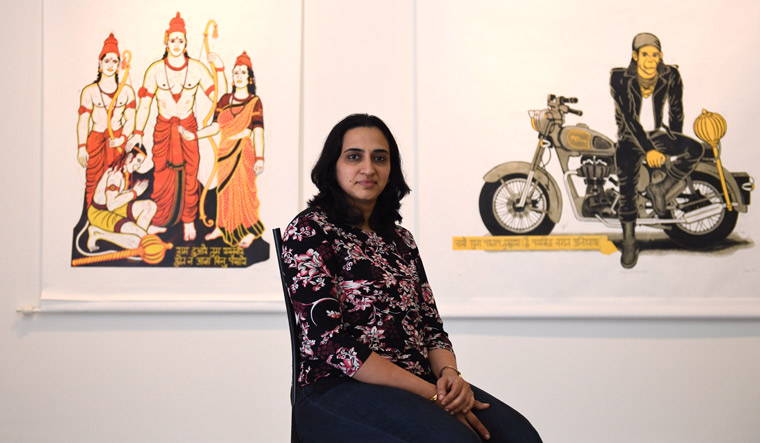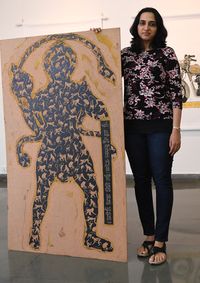Lord Hanuman had been a subtle, but constant presence in Champa Sharath's life during her growing up years.
Champa's home at Sheshadripuram in Bengaluru was surrounded by Hanuman temples. Sometimes she would see him in her dreams.
When she went to Baroda for post graduation, Champa's mother was worried she would be alone for two years. ''She asked me to wear a Hanuman pendant. Happily, I wore it on my gold chain. Now I realise her intentions—Hanuman is believed to be a bal brahmachari (celibate),'' said Champa.
Champa's solo show of woodcut prints titled 'Divine Phantoms', which was on view at Gallery Sumukha in Bengaluru recently, depicted the monkey god in a way that makes him even more lovable. One of her works featured Hanuman sitting on a Royal Enfield. “Had Lord Hanuman been there today, this is how we would find him,” said Champa who believes that an art work should reflect the times. The exhibition featured 20 woodcut works.
Champa's woodcut prints are based on Hanuman Chalisa, the sacred literature composed by Tulsidas. ''Initially I thought I'd stay true to the story. I made some woodcuts but soon I got bored and took a break,'' recalled Champa. Then some of her friends who visited her happened to see her works. ''They said the works may not be relevant in today's times. That got me thinking,'' said Champa who now focuses more on producing art that stands the test of time.
What is it about Hanuman that fascinates her as an artist, I asked her. ''His energy,'' pat came the reply. ''And I think we can relate to him more than any other God.''
Champa is one of the very few women woodcut artists in the country. Woodcut is a laborious art form that requires a great deal of physical energy and a keen eye for detail, said Champa. ''First you draw on the wood block and carve it with wood cutting tools. What is on the surface is printed. The area which is cut doesn't get printed. After cutting, you roll a layer of ink over it, with a rubber roller. Then put the paper over the block and rub it from behind, applying a little pressure so that the impression of the block gets on to the paper,'' she said.
Woodcut art lends itself to bold designs. Her work depicting Hanuman's fight with Kalanemi is just breathtaking. As Hanuman goes to a mountain to get a herb for Lakshmana who is badly wounded in a war, the three-headed demon deputed by Ravana appears before him disguised as a sage. Champa's work captured the fight that ensued in all its fury.
The hints of fiery reds and oranges of a print showing Hanuman setting Lanka afire with his burnt tail linger in my mind even as I headed back home.



